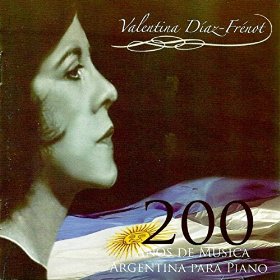MARCH 2015: Valentina Díaz-Frenot: 200 Años de música Argentina para piano
MARCH 2015: Valentina Díaz-Frenot: 200 Años de música Argentina para pianoBy RAY PICOT

When the Argentine pianist Valentina Díaz-Frenot visits our shores, her recitals are memorable and always very well received. It is a pleasure to introduce a recording she made in 2010, in Paraguay, where she now lives with her family. It was inspired by a concert that Valentina gave to celebrate the Bicentenary of Argentine independence, where she gave the occasion perfect context by tracing the evolution of (pianistic) compositional styles over 200 years, which was later expanded for this recording.
It is fascinating that the first composer represented, Amancio Alcorte was the the maternal grandfather of the composer credited with laying the foundation of a recognisable Argentine style, Alberto Williams (born Alberto Williams Alcorta). Whilst Alcorta’s music has an unashamedly European accent, there is much charm on display, which is also true of the collection of short dance-based pieces that accompany his by contemporaries Juan Pedro Esnaola and Juan Bautista Alberdi. Overall the music gives a very good impression of what was the height of musical fashion in Buenos Aires in the mid-19th century. Valentina understands the idiom well, and though the style is harmonically undemanding she plays this collection of minuets and waltzes, with right degree of sparkle and rhythmic care, avoiding saying something that is not true to their style.
What followed next in a few short years was a stylistic step-change as a group of composers of the next generation developed a distinctive Argentine national style, fashioned from the use of folk material and native dances. The two composers Alberto Williams and Julián Aguirre are joined stylistically by Carlos Guastavino who shared their aesthetic and unabashed romantic style.
Julian Aguirre wrote two sets of Aires nacionales argentinos, and we are treated to the complete first set written in 1898, known most often by their generic subtitle, 'Triste', accompanied by 'Huella' and 'Gato'. I have heard these Tristes many times and yet the grace and limpid phrasing Valentina brings is just perfect and they come up fresh-faced to captivate you once again. In the two dances, 'Huella' and 'Gato' we are treated to brilliantly-accented and dramatic accounts.
Alberto Williams' folk-inspired music breathes the air of the wandering gaucho, and we hear two pieces that illustrate the genesis of this new style from the suite, En la sierra Op.32,En la colina and El rancho abandonado. Written in 1890 fresh from his studies in Paris, the underlying European style is transformed very effectively, though to my ears El ranchohas a distinctly Satiean feel. The music is coloured most effectively in this performance and effectively understated.
What follows next seems like a splash of a mountain stream with the exuberant and picturesque style of Carlos Guastavino with Gato and Bailecito, written around 1940, but stylistically coming from another era. These two brilliant dances, though well known, stand out perfectly in these dashing performances. Valentina may have played these pieces many times but they sparkle freshly minted in her hands.
There is some overlap in time with Astor Piazzolla, whose sharply-accented tangos transformed Argentina’s musical image. Milonga del Angel and Muerte del Angel are played with excellent rhythmic phrasing, capturing the essence of these great pieces. The set is rounded off with Chau Paris, a piece written whilst studying with Nadia Boulanger and shows how the composer was developing his style. He liked it well enough to include it on his 1955 album Sinfonía de Tango.
We next step back to 1937 and some early music by Alberto Ginastera, his Op. 2 and 3, with Milonga del árbol del olvido and the Tres danzas argentinas. These pieces show how the composer was bringing the sharply-accented rhythmic music of Bartok and Stravinsky to his developing style without loss of melodic inspiration in the slower pieces. Once more Valentina is completely at home with this music giving us a thrilling virtuoso display in the final dance.
The final piece, included especially for this recording, represents Valentina’s homage to her teacher and mentor for many years, Robert Caamano. The Variaciones gregorianas Op. 15 represents another stylistic step-change, as the composer, who was the Professor of Gregorian Chant at the Institute of Sacred Music in Buenos Aires, writes in a more restrained neoclassical style, using dissonance and serial techniques. This short piece is well written for the piano and sustains interest throughout. It is played very naturally and it is clear that Valentina has a consummate understanding of the composer’s style. It rounds off a memorable recording which I urge you to investigate. It is also readily available to download on iTunes with some of the pianist’s other recordings, which illustrates the full range of her considerable artistry.
Site design and content copyright © 1998-2023
The Iberian and Latin American Music Society, all rights reserved.
ILAMS is a registered charity, No. 1092749